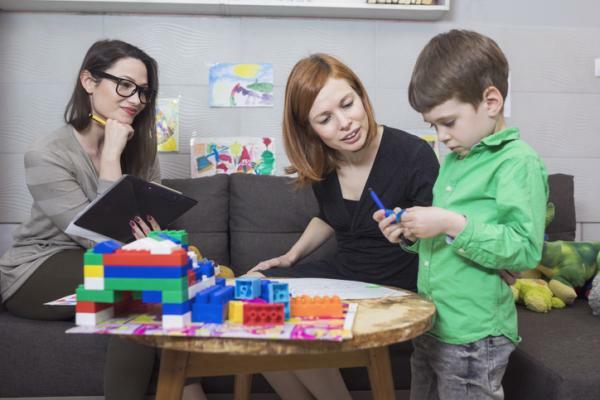
The teacher, during all school hours, only communicates in English and in addition to that, the classroom is fully decorated with materials titled in that language. However, even the boys and girls do not converse one hundred percent in that language, despite the fact that all the instructions and activities are well understood.
This is an observation that coincides with Hurlock's position where she indicates that in repeated studies it has been demonstrated that at all ages the passive or "comprehension" vocabulary is greater than the active or "spoken". For example, babies can understand the general meaning of what is being said to them long before they are able to speak.
We invite you to continue reading this PsicologíaOnline article if you are interested in the Learning foreign languages in boys and girls under 6 years of age.
Index
- About language and speech
- Theoretical framework
- Neurological bases of speech
- About bilingualism
- Notes on learning a new language
About language and speech.
It is essential to highlight one substantial difference between language and speech. For Hurlock, language "encompasses all means of communication in which thoughts and feelings are symbolized so that they make sense to others. It includes such different forms of communication as writing, speech, sign language, facial expressions, gestures, pantomime and art. " For the same author, speech "is a form of language in which articulated words or sounds are used to communicate meaning".
Many experts emphasize that a child's brain is very plastic. In this regard, Mr. Aarón Ocampo, professor of the Psychophysiology course at the Latin University of Costa Rica, indicates that the child is are forming the connections of neurons and that the stimulation that occurs at this time will contribute to the formation or not of said connections.
Theoretical framework.
Regarding this issue, Educational Psychologist Dr. Roberto Rodríguez believes that from birth to 12 years of age he develops neurological maturation of learning and is where you can learn languages more easily than in later years, due to what understanding is moldable and there are no social pressures such as fear of criticism for mistakes in pronunciation or writing.
For Carlson, brain development begins in the first days of the development of the embryo. Once neurons reach their destinations, they begin to form connections with other cells. They develop dendrites, which receive the terminal buttons of the axons of other neurons, at the same time that they generate their own axons; all this influenced by chemical and physical factors. The neurons that receive these buttons and axons must also work hard for the connection to take place.
Carlson also mentions that nature is very wise, as the brain initially produces 50% more than cells to form synaptic connections, but if they fail to establish those connections, they die. This confirms the fact that if a person is not stimulated in his first years of life, the unmotivated areas will not achieve a synapse, and if they do not occur, these neurons will To die. This is a very suitable evolutionary process, where neurons will compete to make these connections.
Neurological bases of speech.
Speech in humans is very complex, since it involves various areas: occipital, temporal and parietal lobes. It is important that the person has something to talk about, and this will be the product of memories, imaginations or perceptions, but there must always be a baggage.
It should be noted that two key skills are involved in speech, the first is a motor ability, as there are a large number of muscles involved in this process. The second is the mental ability, also vital, since it is necessary to understand the words and associate a symbol to each one, relate concepts and string together ideas, to give a few examples. To these abilities are added the need for maturity of the child's body, because no matter how much he or his parents want it, he will not speak until his body is mature to achieve it.
Two regions vital for speech to occur in particular stand out: Broca's area and Wernicke's area.
The first is in the region of the left frontal lobe, contains memories of the sequences of muscle movements required to articulate the words. A person with an injury in this area is characterized by slow, difficult, and not fluent speech. Wernicke's second area It is located in the middle and posterior parts of the superior temporal gyrus of the left hemisphere and his function is to recognize the spoken words, is a complex perceptual task that is based on sound sequences. A person with damage in this area is characterized by a deficit in speech compression.

About bilingualism.
As far as language learning is concerned, Dr. Rodríguez recommends that the child first learns the language spoken where he lives, that is, the area where it takes place. This is due to the fact that this influences the social development of this person, which will allow them to feel better adapted and able to relate to people around him, such as his teachers and classmates, etc. After you acquire this domain, you can start teaching another or other languages. Otherwise, self-esteem would be at stake, because if he cannot communicate well he will feel displaced, or he will isolate himself.
Indeed, in the long term, foreign language knowledge provides the individual with rewarding advantages not only personally, but also professionally and academically. According to Mr. Mario Maroto Lizano, General Manager of Lafise Bank, learning another language brings culture, which allows the human being to have a more open and adaptable way of thinking. He also recognized that in certain professions knowledge of a foreign language is vital. For example, a doctor who does not speak English is exposed to a delay in his technical knowledge and scientific, as advances in the field of medicine are published in English and long afterwards in other Languages. Thus, this issue of foreign languages also contributes to professional competitiveness.
On the other hand, some complications, affirms the Educational Psychologist and Renzo Titone, can be derived from a premature start of foreign language teaching, because until approximately 3 years of age, the child achieves that his native language is well developed and it is from this moment that he recommends the introduction of the learning of another language, since before the child confuses the learning and is not defined by a single language and may show delays in its communication process, and there may even be the need to resort to speech therapy due to sentence structuring problems, pronunciation, etc. Also, many times, these cases are misdiagnosed as "language problems" being perhaps just a weakness in pronunciation.
On the other hand, points out Dr. Rodríguez not allchildren have the same facility to learn another languagea, not only for intellectual capacity but above all for learning skills as problems of auditory or visual discrimination, increasing the complexity in learning the new language or idiom.
Here it is important to establish the difference between "learning an additional language" versus "learning with an additional language" this The latter means that formal education (courses in mathematics, science, history, etc.) are taught in the language Foreign; The first point refers to the fact that these courses are carried out in the native language and, on the other hand, are complemented by a learning program for another language.
Rodríguez's position is supported by Hurlock who affirms that there are conditions associated with bilingualism that can be dangerous for good adaptation and that can cause negative effects on:
- Social adaptations
- School works
- Speech development
- Thought
- Social discrimination
- The fact of being different
Notes on learning a new language.
There are Remedial Programs that help support the child in the weakness of the second language, if any; If this does not work, it is appropriate to change the educational institution before exposing him to academic failure and a deterioration of his self-esteem.
Together, there are a series of qualities that children have from the age of 3, which without a doubt should be used: a child from 3 to 6 years old will have fewer difficulties in learning a second language compared to another child in primary or secondary school, since the perception of Rejection is more sanctioned and produces more social shame in early middle childhood, but not during early childhood, explains Dr. Rodriguez.
For Hurlock there are some elements that promote language learning:
- The satisfaction of verbally expressing needs and wants to others.
- Get the attention of others through speech.
- The ability to express oneself with others in an understanding way, thus increasing social relationships.
- Acceptance by the social group.
- If there is an acceptance of the social group, their self-evaluation is high, otherwise the opposite case occurs.
- An adequate capacity for expression influences positive academic achievement.
In addition, the influence of the media Like music, internet, television, they are a very valuable contribution as a facilitator of learning, indicate Messrs. Maroto and Rodríguez.
Finally, Dr. Rodríguez states that the child learns a language because it will work for him and allows him to be understood through his ability to communicate, being therefore the first form of communication is oral, that is, speech, so the teaching of foreign languages should also focus on the oral domain, in the first instance and then the written.
In addition, the oral is audible and can lend itself to making the child feel criticized, rejected by some mistake in pronunciation (especially in older ages), therefore, the teaching methodology is influential; if games, songs, drawings, etc. are used. It will create a stimulating and pleasant environment for the learner. The continuity and the time invested is important, according to Dr. Rodríguez it would be ideal for the child to be exposed at least 3 hours to learning the foreign language.
Finally, Hurlock recommends the presence of several fundamental aspects for good learning of a language:
- A good role model: Words must be pronounced correctly for children.
- Practice opportunities: This encourages them to be motivated to learn to speak another language.
- Motivation: recognize their effort on learning with recognitions or awards.
- Guidance: correct mistakes made in pronunciation or writing.
Andrey will be a child who will be more easily incorporated into this globalized world, where mastering two or more languages will generate significant competitive advantages.
This article is merely informative, in Psychology-Online we do not have the power to make a diagnosis or recommend a treatment. We invite you to go to a psychologist to treat your particular case.
If you want to read more articles similar to Learning foreign languages in children under 6 years of age, we recommend that you enter our category of Education and study skills.


